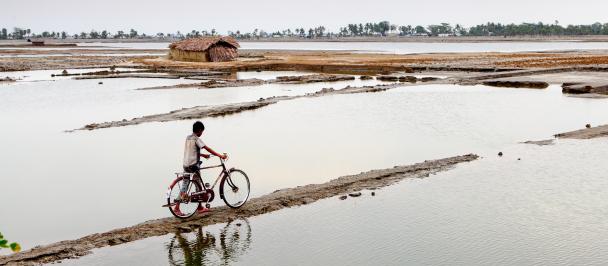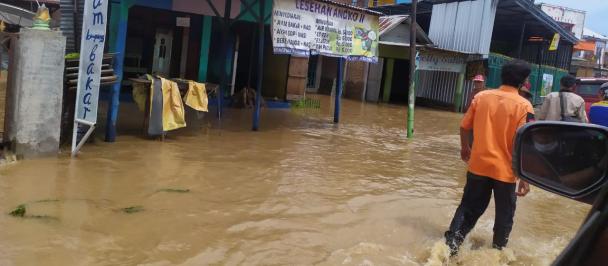Author: Philip Schellekens, Chief Economist - UNDP Asia and the Pacific & Shahid Yusuf Chief Economist - The Growth Dialogue
Accelerating growth in Indonesia: An industrial policy for the rural informal sector
March 11, 2025

This blog was orginally published in the Future Development on the website of Brookings Institution.
Informality is often likened to a persistent low-grade fever; it drains resources and stifles growth. The small scale, technological limitations, and low productivity of informal enterprises weigh heavily on the economy, leaving policymakers grappling for solutions.
In Indonesia, the cost of informality is coming into sharper focus as the Prabowo administration seeks to accelerate economic growth. With poverty eradication also high on the agenda, rural informality demands particular attention.
This blog examines how a fresh approach to the rural informal sector could unlock national economic growth. Specifically, it explores how rural industrialization—driven by an industrial policy tailored to the informal economy—could be a catalyst for faster development.
Informality in Indonesia
Indonesia’s informal sector accounts for 36% of GDP, and an astonishing 59% of the nation’s 144 million workers are engaged in informal activities. Informality in rural Indonesia is typical of other Southeast Asian countries. Most activities are small-scale employing less than 5 workers and self-employment is common, production whether of goods or services is labor intensive, workers are generally unskilled or semi-skilled, more women than men are engaged in informal activities, productivity and earnings are well below those of workers in the formal sector, and representation is higher in the services sector (e.g., retail, transport, repair, hospitality). Informal units are not subject to official regulation or taxation and do not benefit from the social safety net, if any. They do not register to avoid taxes, and because they are reluctant to grow or borrow from the formal banking system.
With the Prabowo government aspiring to grow the economy by 8% per annum while eradicating poverty, there is an urgent need to reduce informality and facilitate the transition of resources from the informal to the formal economy. The elusive goal is a policy package that could spark a virtuous cycle: boosting the productivity of informal businesses, enhancing their contribution to economic growth and ultimately integrating them into the formal sector. We believe that the industrialization of the rural informal sector might do the trick, but this will require a rethink of the policies required for support.
Industrial policy for the rural informal sector aims to develop manufacturing activities in selected rural areas that initially meet local demands for processed foodstuffs, household goods, paper and ceramic products, construction materials, agricultural chemicals, and other items. These would create non-farm jobs and once they acquire traction, could be scaled up with successful businesses merging with the formal sector. To succeed, it would need to be trialed in carefully selected locations as specified below.
Lessons from international models
The experiences of China and Taiwan offer support. In both these economies, the modernization of agriculture and the emergence of rural manufacturing activities raised labor productivity, serviced many of the requirements of the local population, increased the investible surplus, and generated exports.
In China, the decollectivization of agriculture in the late 1970s raised land productivity and permitted township and village enterprises (TVEs) to proliferate. Supported by local authorities, the number of TVEs increased from zero in 1978 to 17 million in 1988. These informal enterprises initially met rural demand for machinery, inputs, and consumer goods. This was partly responsible for the increase in the average annual growth of agricultural output from 2.9% in 1952-1978 to 6.3% between 1978 and 1987. The mushrooming of TVEs also boosted by 2% or more China’s GDP growth from the 6.5 average rate during 1980-1981 to 11.47% from 1982 to 1988. As incomes rose, TVEs expanded into construction materials, consumer durables, and subcontracting for urban state-owned enterprises (SOEs). By the mid-1980s, they were key exporters that fueled China’s rapid growth. In the 1990s, many evolved into large firms within the formal sector, driving in situ urbanization as villages transformed into towns and cities through manufacturing.
Taiwan underwent a similar transformation, starting from a stronger agricultural base shaped by Japanese colonial policies (1895–1945). In the 1950s and 1960s, a modernizing agriculture sector generated high-value exports of vegetables, fruit, tea and sugar, and spurred small-scale informal manufacturing, laying the foundation for Taiwan’s SME-driven growth. Initially focused on food processing and agricultural tools, SMEs expanded into textiles, bicycles, and appliances, and by the 1970s, they were producing higher-value electronics and machinery. Like South Korea, Taiwan’s success was tied to export-led industrialization, with early growth rooted in the rural informal economy, similar to China.
Strategic Recommendations for Indonesia
Indonesia’s agriculture is a major economic force producing palm oil, rubber, coffee, cocoa, tea, fruit, spices, rice and other staples for export and domestic consumption. Large plantations coexist with smallholder agriculture and together they comprise a substantial market for agricultural inputs, machinery, consumer goods and construction materials for infrastructure and housing. Currently most of these are procured from urban suppliers or imported. More than one half of the informal workforce—43.5 million people—is rural.
Following the example of China, Taiwan, and countries in Latin America where agriculture is a leading sector, Indonesia could add 1-2 percentage points per annum to its longer-term growth rates. This can be accomplished by strategically implementing an industrial policy for the rural informal sector, leveraging the large informal workforce currently adding little value, and taking advantage of ongoing electrification. As in China, at first, rural industry would be servicing mostly local or provincial demand and increasing the productivity especially of smallholders, which is well below that of plantations and a fraction of the theoretical maximum. As it moves up the learning curve, acquires scale and some firms become formalized, rural industry could complement and add value to the exports of agricultural commodities.
China demonstrated the advantage of first testing a policy in a selected locale and working out the kinks before implementing it more broadly. A phased approach would be the prudent course for Indonesia as well. The experimental rollout of an industrial policy for the rural informal sector should be in a region with (1) a large modernizing agricultural system; (2) a well-staffed local government with implementation capacity and a strong revenue record; (3) a labor force with baseline education and technical skills; and (4) adequate infrastructure.
A pilot in either Java or Sumatra in the vicinity of a city such as Medan would be ideal. This would permit nascent rural industry to benefit from urban services and develop a supply chain.
The support to the rural informal sector must take account of existing programs, assess their impact to date, learn from successes and failures and use them where appropriate to buttress rural industrialization. In addition, it would be important to identify and involve the major stakeholders, such as foreign companies, NGOs, research, education and training institutions, and cooperatives.
A coordinated targeting of the principal drivers and bottlenecks would impart the needed momentum. A strong local government with the backing of the center must play an active role, devise a workable strategy, and test instruments to stimulate start-up activity. Targeting will be guided by the composition of agricultural activities and crop yields, and the sophistication and productivity of current activities. Manufacturing is more likely to flourish where agriculture is being “industrialized,” with increased use of machineries, chemical and biological inputs, and modern capital-intensive techniques of planting, harvesting, and downstream processing (e.g., palm oil, rubber, rice, fruit, and other food crops).
One important initiative would be to scale up (public and private) venture capital for start-ups, building on an existing program. This could include creating a few publicly owned firms in selected activities to demonstrate opportunities and technologies and help train and spur local entrepreneurship. Incubators and accelerators tailored to opportunities and available skills in rural areas could enlarge the population of young firms. Low and medium tech activities can benefit from incubators just as much as high tech activities.
Support to the transport and digital sectors, which directly facilitate manufacturing activities in the pilot areas, could ease bottlenecks. Such investments coordinated with the plantation sector would give rise to demand for construction materials and to jobs. An efficient transport system would reduce time to market and absorb more workers into productive employment. This would create openings for informal enterprises to supply both goods and services. Digital infrastructure plus some training would widen e-commerce market channels for rural firms, some of which already have a digital presence. China’s Rural Taobao Program can be a point of reference.
From pilot to policy
An industrial policy for the rural informal sector could deliver quick wins. As with any policy, success is not guaranteed, but a pilot project is a low-cost option that can be adjusted or discontinued if necessary. However, if successful, it could pave the way for broader rural industrialization across Indonesia and transform informal enterprises into a driving force for economic growth.

 Locations
Locations


